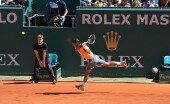The lost art of defending
Written by Suhrith // February 6, 2011 // Sport // 4 Comments
The illustrious Italian journalist, Gianni Brera is reported to have once written that ‘the perfect football game would finish 0-0’. Going by his philosophy, yesterday’s seven Barclays Premier League fixtures in which forty one goals were scored would represent hugely imperfect contests. Goals, though, some would say, always make for a satisfying treat and it may be wise to shun the larger tactical causes and enjoy the occasions as it were. But even if we were to disregard the views of Brera, which may appear to border on the ludicrous, goals that result out of defensive lapses of amateurish magnitude and a lack of tactical acuity from the teams are of far inferior alluring value.
A significant part of football’s splendour lies in its low scores. Goals are meant to be a premium and a team’s ability to defend competently while not compromising on its attacking options is a vital element of the sport, and contributes towards much of its beauty. Spectacular as some of yesterday’s games were, they were marked by particularly pitiful defending. The Newcastle United–Arsenal fixture, for instance, embodied a typical game of two halves, only though for all the wrong reasons. Arsenal were no doubt irrepressible in the first period, spraying incisive passes that tended to beguile, but the nature of Newcastle’s defending must have had its fans cringing in anguish – the space that was allowed to each of the scorers to either stroke or head home their finishes was quite inexplicable. In the second half, it was the turn of the Arsenal fans to cringe as their team somehow contrived to let slip a four goal lead. Some would point to the red card accorded to Abou Diaby that preceded Newcastle’s goals as the basis of Arsenal’s failings, but the incident only served to mask their otherwise deplorable defensive showing.
At the Molineux, Manchester United, hitherto unbeaten and perched at the top of the league, scored inside three minutes before allowing Wolverhampton Wanderers to equalise and take the lead inside the first half by committing acts of footballing hara-kiri. Rafael’s decision to turn his back on Matt Jarvis and allow the Wolves winger to take a quick corner led to a free header for George Elokobi for the equaliser before Nenad Miljas’s floated free-kick was bundled in by a gratefully unmarked Kevin Doyle to give the home side an advantage that eventually proved insurmountable.
A glimpse at the highlights of the other games played yesterday and a reading of the match reports clearly indicate that wretched defensive performances pervaded across the league. Maybe this was nothing more than a flash in the pan, with a rare concoction of attacking brilliance and shoddy defending providing a day of nutty entertainment. But defensive frailties have been at the root of the problems of almost all teams near the top of the League. Nemanja Vidic has, perhaps, been the outstanding defender in England this season, but as a team United have looked dreadfully vulnerable from set-plays. Manchester City have been steadier than most at the back, but a centre-back pairing of Vincent Kompany and Kolo Toure does not always inspire the greatest confidence. Arsenal’s failings are far too well documented to hark back upon, while Chelsea have the found the need to splash twenty-five million pounds on David Luiz, a young centre-back of supposedly rich talent. Are these problems, though, a mere reflection of the quality of players or are they a product of greater tactical causes?
Zonal marking from set-plays – where defenders mark specific zones of the penalty box as opposed to an assigned opponent – has often been derided as a tactic incapable of providing success. Every time Liverpool conceded a goal from a set-piece during Rafael Benitez’s tenure, it was attributed to ‘inherent flaws’ of the zonal marking system that was in operation. Yet, when teams using a customary man-to-man marking method concede goals from set-pieces, rarely is it considered a result of the system, with only its poor implementation deemed as the cause – best exemplified by Liverpool’s own movement away from the arrangement.
For all the hostility against the method, in theory, zonal marking seems a sensible tactic. By stationing its best defenders in the most dangerous zones inside the penalty box, a team is quite likely to alleviate the pressures of defending its goal. One of the primary concerns against the system relates to a defender’s ability to deal with attackers who have a run on them. But as Howard Wilkinson says: “Attackers get a run on you whether you are zone defending or man-for-man marking. They always call the shots. You start from a standing position but once the ball is in flight, you’ve got the distance the ball travels to get yourself moving.” Of greater practical significance, though, is Alan Hansen’s statement that the use of the system by the hugely successful Liverpool teams of the 70s and 80s of which he was a part, never weakened their ability to win Championships in England or in Europe.
An interesting parallel may lie in the larger movement towards zonal marking as a holistic defensive strategy. For many years, teams had defended by assigning a specific defender to deal with each of the attackers with the very notion of marking in zones considered antithetical to football strategies. Luis Vincio at Napoli in the mid 1970s and Nils Liedholm at Roma in the early to mid 1980s had tested a system involving zonal marking with variable success, but it found its perfect synthesis only under Arrigo Sacchi at AC Milan in the late 1980s. Sacchi’s system entailed pressing in zones and concentrating on marking space as opposed to marking in relation to the position of individual players. The success of his Milan side is often considered the last great tactical revolution, with almost all modern-day teams applying a version of the system. Yet, when it comes to defending set-pieces, a general opposition to zonal marking continues to persist. In almost all of the six seasons under Benitez, Liverpool were amongst the teams that conceded the fewest goals from set-pieces – a statistic that should be a celebration of the tactic as opposed to the misplaced indictments that are often served out.
On the face of it, a tally of forty one goals in seven league games is suggestive of a league that is brimming with attacking excellence. Behind the facade, though, lie the blighted defences that constitute the more telling cause behind the goal-glut. Any argument in favour of the Premier League’s quality must be softened by its defensive artlessness, which runs counter to one of the fundamental elements that makes football beautiful.




4 Comments on "The lost art of defending"
Liverpool defensive tactics still look solid under Dalglish having watched their fortitude against the onslaught by Chelsea with the newly acquired Torres. Dalglish was a little disappointed by the timing of Torres’ transfer, but I am sure he is delighted that Liverpool have now won 4 games in a row without conceding. So much for the art of defending.
From a dejected arsenal fan. Wish you had mentioned the enormous role played by Philip Dowd.
You’re spot on. Liverpool were excellent last night, and the decision to play three centre-backs worked very well. I can’t, though, help but think that much of their defensive organisation is down to Steve Clarke, who has to be amongst the finest coaches in the world.
And with respect to Dowd, as much of a role as he may have played, Arsenal can still have no excuses. Some of their defending in the second half was quite appalling.
Excellent article Suhrith. Nice to see someone giving credit to Benitez and his implementation of the zonal marking system given the endless flak he received for it. Though part of why Liverpool were so defensively solid under Benitez was the defensive of course the personnel, especially Sami Hyypia, one of the finest defenders to have played in the PL in the last decade.
Many thanks Dhananjaya. I agree. The personnel at disposal is vital to the workings of a zonal marking system.